Shopping here means massive savings, but why is Aldi so cheap when other grocers jack up prices? We found out.
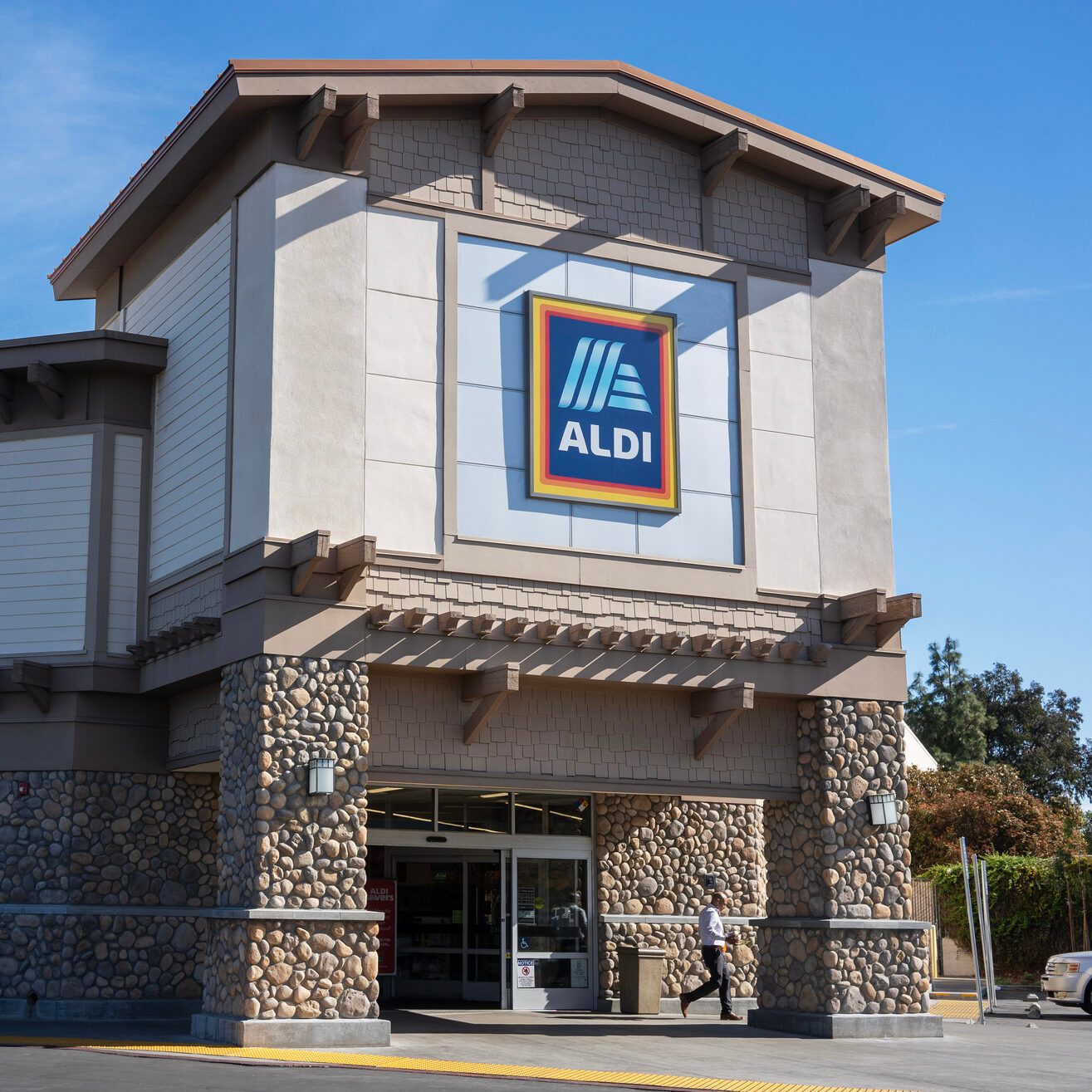
Here’s Why Aldi Is So Cheap

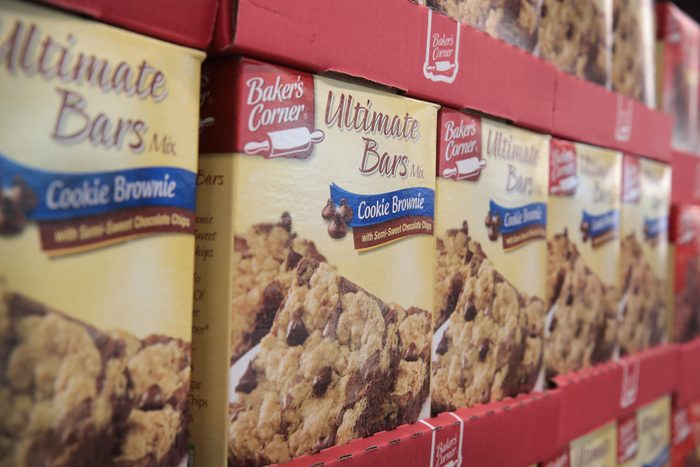
It relies on store brands
Generic goods, house brands or private-label products—no matter what you call them, they’re a win for customers and grocery stores. And they’re a big reason why Aldi is so cheap. While the store does carry some household names (think: Campbell’s and Crest), you’re more likely to see Aldi’s private-label brands instead. They’ll typically look similar to—but not exactly like!—familiar brand-name products. Take, for instance, Millville Crispy Oats, Aldi’s take on Cheerios, and Baker’s Corner, its version of your favorite baking brands.
“The private-label program by Aldi is their secret sauce,” says shopping expert Nick Drewe, the CEO of Wethrift, a company that helps consumers save via coupon codes and discounts. “It makes up around 90% of what they sell, not national brand names. Since there are no middlemen and they buy products directly from wholesalers, they skip the extra markup associated with big-name merchandise. This puts them in charge of ingredients, quality and, most important, price.”
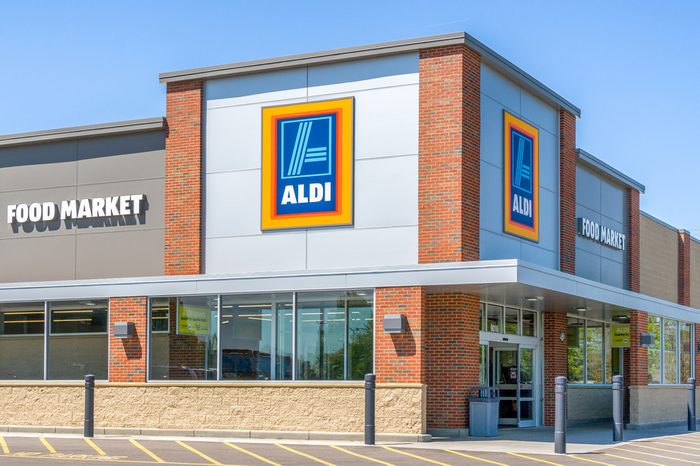
Its stores are smaller
A quick glance around any Aldi will tell you that the store’s footprint is smaller than that of your average supermarket. This means Aldi can carry fewer products than a regular grocery store—closer to 1,650 different items, or SKUs, compared with the 30,000 you’ll find at a larger grocer.
But that’s not a bad thing. In fact, it helps Aldi keep prices low. “Aldi stores are smaller than typical supermarkets, leading to lower rent and utility expenses,” says Alexander Ketter, a money-saving expert at Coupons.com. Lower rent and utilities mean that Aldi can pass that savings on to shoppers.
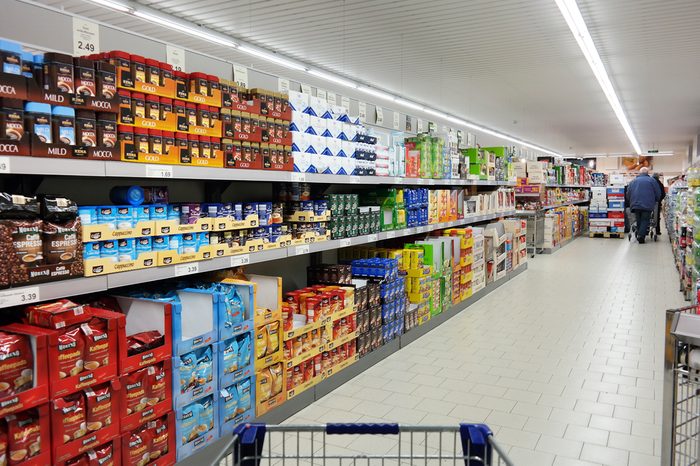
It takes less time restocking shelves
Creating grocery displays and restocking shelves can be time-consuming and burdensome tasks, and they require more employees. Aldi has a clever way of dodging these costs.
“They use those ‘open the box’ presentations where products are just placed inside their shipping containers with the lid taken off instead of individually packed on the shelf,” Drewe says. “This helps lower the cost of labor.”
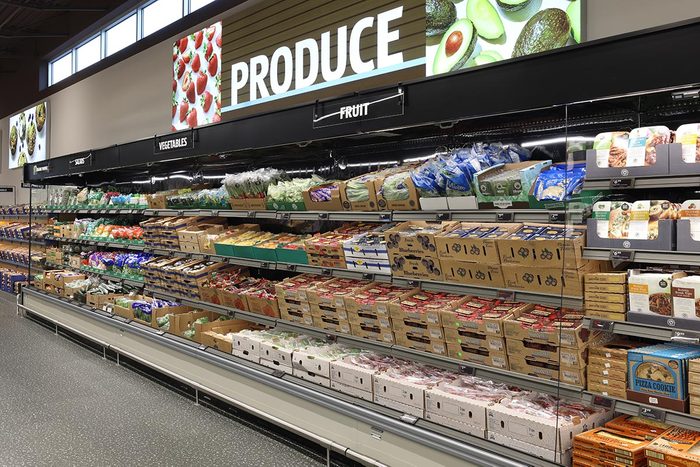
It relies on prepackaged milk and produce
Imagine how long it takes grocery employees to place individual milk cartons into a display by hand. Talk about a time-consuming task! Because Aldi moves milk in prepackaged racks, it can quickly replenish the dairy section. This is another smart way to reduce labor costs.
On top of that, you’ll notice that a lot of the grocery store produce is prepackaged, which means it doesn’t have to be weighed by a cashier at checkout. It seems like a small task, but it can add up to a lot of hours. And you know what that means: more employees and more labor costs for a grocer to pass on to you.
Yes, you can still purchase broccoli and bananas by the pound, but for the most part, Aldi’s produce has been bagged, weighed and marked with its final price. And your bill is smaller for it.

Its stores are energy efficient
Back in 2017, Aldi announced a major investment in its future, remodeling 1,300 stores in the United States. While the investment in this revamp was a costly $1.6 billion, it held the promise of savings down the line.
One part of the remodel included installing LED lighting to reduce energy consumption by 10%. In the process, Aldi also created open ceilings to allow natural light to shine in and invested in energy-saving refrigeration. This can save each Aldi location up to $15,000 a year in utility costs. And the store will then pass those savings on to you by keeping prices low.

It hires fewer employees
Aldi relies on a few tricks to reduce its labor needs, and that adds up to big savings for the company—and you. Plus, it manages to use fewer grocery store employees without sacrificing shopper experience.
“Their multi-role staff approach is great as well,” Drewe says. “The same individual might stock, operate the checkout and sweep the floors, keeping staff requirements lower.”

It sells bigger-ticket items
So-called Aldi Finds, the nonfood items you’ll find in the center of the store (think: lawn mowers and computers), bring in the big bucks. And those sales boost Aldi’s profits enough that the store can keep food prices low.
“The high-margin products subsidize bottom-of-the-barrel prices on staples,” Drewe says. “It is worth it because the special buys somehow encourage a sense of urgency—customers know that if they don’t purchase that sale air fryer today, it will be gone tomorrow. This time-limited strategy earns good margins without sacrificing their value reputation throughout the shopping center.”
Still, even if you do shell out more money for those Aldi Finds, Ketter says shopping at Aldi can save consumers up to 40% compared with traditional grocery stores. He notes that, in 2023, the average U.S. household was spending approximately $832 per month on groceries, which means Aldi households have the potential to save more than $300 a month.

It rents shopping carts
Raise your hand if you’ve ever hit the Aldi parking lot excited to shop, only to discover you don’t have a quarter in sight. This isn’t a big deal at other grocery stores, but at Aldi, you need that quarter to snag a shopping cart.
As part of the store’s shopping-cart rental process, you’ll pay a quarter for the cart, and then, when you put the cart back after your shopping trip, you can retrieve the quarter.
At first, the whole routine seems kind of ridiculous—why is Aldi so cheap when you have pay just to use a cart? But it’s actually another way Aldi saves money. “One of Aldi’s less subtle but more creative plans is their quarter-deposit cart program,” Drewe says. “It may seem like a small thing, but it prevents staff from having to go retrieve carts from the parking lot.”
It’s all in the name of keeping labor costs low.

It skips traditional advertising
You won’t see a ton of Aldi television commercials or hear the store announce prices on the radio. The company isn’t spending its money on advertising.
What Aldi does pay money for is research to determine how its prices stack up to competitors—so it can then blow their savings out of the water. Its 2025 report found that, compared with national grocers, Aldi can save a family of four nearly $4,000 on groceries a year.
Eschewing advertising spending also leaves the company with more money to offer nostalgic price points. Take, for example, its 2024 Thanksgiving promotion. Aldi rolled prices back to 2019 numbers so that shoppers could feed a table of 10 for just $47. That shopping list included a Butterball turkey, gravy, rolls, mac and cheese, stuffing and the ingredients for cranberry sauce, mashed potatoes, sweet potato casserole, green bean casserole and pumpkin pie.
“With 25% of U.S. households now shopping Aldi, we know grocery prices are still top of mind for customers,” Aldi CEO Jason Hart said in a statement. “We worked hard this Thanksgiving to deliver the best value and quality products so everyone can enjoy a traditional meal with family and friends without having to scale back.”

There’s no pricey loyalty program
These days, it feels like every store has a loyalty or rewards program. Well, every story except Aldi. The budget grocer skips these gimmicks while other supermarkets may pay around $500,000 to create an in-house program.
The retailer did, however, spoof the very idea of a loyalty program back in 2024, when it faux-launched Aldi+. That announcement was immediately followed by another, proclaiming the program a joke and reminding shoppers that, unlike other retailers, Aldi doesn’t do exclusive memberships.
If loyalty programs “aren’t an Aldi thing,” what is? According to an April 2024 press release, “great products at everyday low prices with no additional fees—unless you count the quarter needed to unlock your cart, which you get back when your cart is returned.”
About the experts
|
Why trust us
At Reader’s Digest, we’re committed to producing high-quality content by writers with expertise and experience in their field in consultation with relevant, qualified experts. We rely on reputable primary sources, including government and professional organizations and academic institutions as well as our writers’ personal experiences where appropriate. For this piece answering “why is Aldi so cheap,” we verified all facts and data, backed them with credible sourcing and will revisit them over time to ensure they remain accurate and up to date. Read more about our team, our contributors and our editorial policies.
Sources:
- Nick Drewe, CEO of Wethrift; interviewed, March 2025
- Alexander Ketter, consumer expert at Coupons.com; interviewed, March 2025
- Grocery Dive: “Grocery industry profit margins fall to pre-pandemic levels: FMI”
- Choice Hacking: “Aldi’s psychological secrets for rapid growth”
- Aldi: “Aldi Unveils $1.6 Billion Nationwide Store Remodel Plan to Enhance Customer Shopping Experience”
- Electro-Matic: “How Much Can LEDs Save Your Business Per Year?”
- Open Loyalty: “The True Cost of Building a Custom Loyalty Program In-House”
- Aldi: “Report Confirms ALDI Offers the Lowest Prices of Any National Grocery Store, Saving Shoppers $8.3 Billion Per Year”
- Aldi: “Aldi Commits to Thanksgiving Prices Lower Than 2019, Feeding 10 People for Less Than $47”
- Aldi: “Aldi Unveils New Membership Program with 331.9 Million Members on Day One”




















